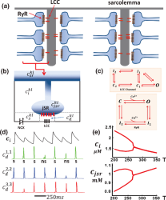Calcium Alternans is Due to an Order-Disorder Phase Transition in Cardiac Cells
Apr 20, 2015
Enrique Alvarez-Lacalle, Blas Echebarria, Jon Spalding, and Yohannes Shiferaw. Phys. Rev. Lett. 114, 108101 (2015)
Electromechanical alternans is a beat-to-beat alternation in the strength of contraction of a cardiac cell, which can be caused by an instability of calcium cycling. Using a distributed model of subcellular calcium we show that alternans occurs via an order-disorder phase transition which exhibits critical slowing down and a diverging correlation length. We apply finite size scaling along with a mapping to a stochastic coupled map model, to show that this transition in two dimensions is characterized by critical exponents consistent with the Ising universality class. These findings highlight the important role of cooperativity in biological cells, and suggest novel approaches to investigate the onset of the alternans instability in the heart.

Share: